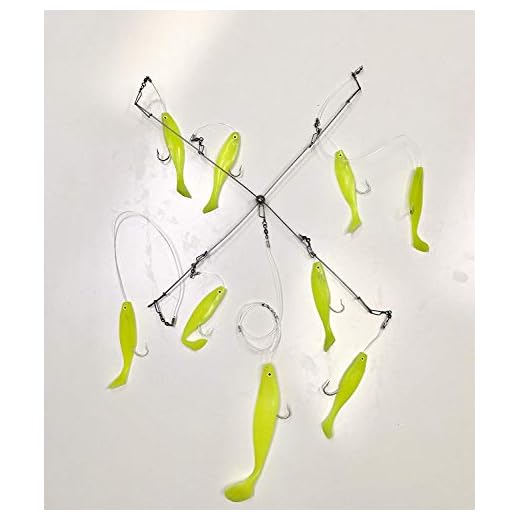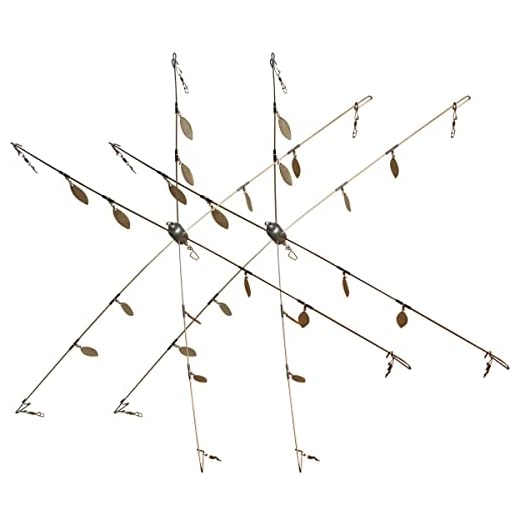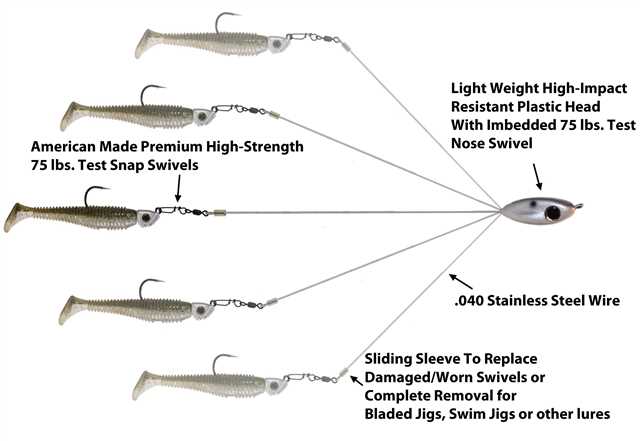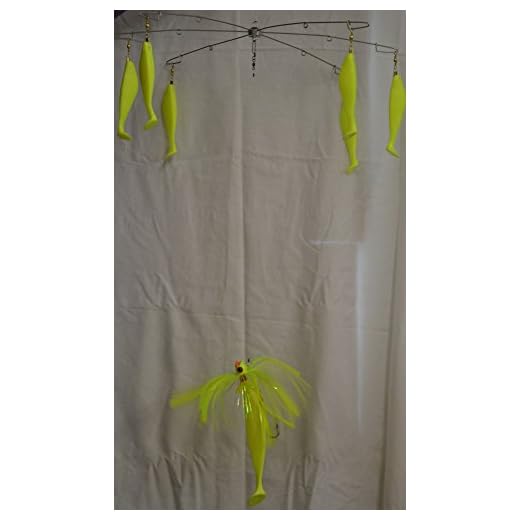




Choosing the right shades for your rigged lures can significantly enhance your fishing success. This article highlights the most effective hues that can attract various species, ensuring you have a productive outing on the water.
This guide is tailored for anglers looking to improve their catch rates by utilizing the right lures. Whether you’re a novice or an experienced fisherman, understanding the psychology of fish and how certain shades can trigger strikes is crucial.
Within this piece, you’ll find a breakdown of specific shades that perform exceptionally well in different environments and conditions. From natural tones that mimic baitfish to bold colors that stand out in murky waters, this article provides actionable insights to elevate your fishing game.
Best Keitech Colors for Umbrella Rig
When selecting hues for your fishing strategy, certain shades stand out due to their proven effectiveness. Natural patterns that mimic local baitfish can significantly increase your chances of attracting attention from predatory species. Colors that resemble shad, bluegill, or other common forage in the area often yield the best results.
Adding to this, contrasting shades can create a striking visual that triggers a predator’s instinct to strike. Dark colors in low-light conditions can enhance visibility, while brighter, more reflective options may be advantageous in clear waters. Experimenting with these variations can lead to successful outcomes in your angling endeavors.
Recommended Options
- Shad Patterns: Silver and white combinations effectively mimic baitfish.
- Green Pumpkin: A versatile choice that resembles various natural prey.
- Chartreuse: Bright and easily noticeable, ideal for murky waters.
- Black and Blue: Works well in low light, creating a strong silhouette.
Consider the following factors when choosing your lures:
- Water Clarity: Adjust your selection based on how clear or murky the water is.
- Weather Conditions: Overcast days may call for darker tones, while sunny days benefit from brighter hues.
- Seasonal Changes: Fish behavior and forage availability can shift with the seasons, influencing color choice.
| Condition | Recommended Color |
|---|---|
| Clear Water | Shad Patterns |
| Murky Water | Chartreuse |
| Low Light | Black and Blue |
| Sunny Day | Green Pumpkin |
Experimentation is key. Adjusting your approach based on local conditions and the species you target can enhance your success rate significantly. The right hue can make all the difference in your fishing experience.
Color Selections for Freshwater Species
Choosing the right shades can significantly enhance your fishing success when targeting freshwater species. Various hues attract specific fish types, increasing your chances of a successful catch.
For many anglers, natural tones tend to yield positive results. Shades that mimic local forage are often preferred. For example, hues that resemble shad or bluegill can be particularly effective in lakes and rivers.
Effective Color Options
- Green Pumpkin: This muted shade mimics a variety of natural prey, making it a versatile choice.
- Watermelon: Excellent in clear waters, this shade blends well with aquatic vegetation.
- Chartreuse: Bright and visible, this color can trigger aggressive strikes, especially in murky waters.
- Black and Blue: A classic combination for low-light conditions, often preferred by bass.
- Brown: This earthy tone closely resembles many bottom-dwelling creatures, making it appealing to various species.
Selecting the right hues can lead to better results, especially when considering water conditions and time of day. Experimenting with different shades during outings can help identify what resonates most with local fish populations.
Effective Shades for Saltwater Fishing
Choosing the right hues can significantly enhance your success in saltwater fishing. Natural tones that mimic local baitfish often yield better results, especially in clear waters. Shades like pearl, silver, and ghost can be particularly appealing to predatory species.
In murky conditions, brighter options tend to stand out more effectively. Neon hues such as chartreuse, pink, and orange can create a striking contrast, attracting fish even in low visibility. These shades are especially useful during overcast days or in deeper waters.
Considerations for Color Selection
- Water Clarity: Use natural tones in clear waters and brighter shades when visibility is low.
- Time of Day: Early morning and late evening may require more vibrant hues as light fades.
- Species Targeted: Research the feeding habits and preferences of local fish to choose accordingly.
Experimenting with different shades can help identify what works best in specific locations and conditions. Keeping a detailed log of successful outings can refine your choices over time.
Seasonal Variations in Color Preference
During the spring, brighter shades tend to attract more attention, particularly among species that are more aggressive and active as temperatures rise. Utilizing hues that mimic natural forage such as shad or bluegill can lead to increased success during this time. The warming waters trigger feeding frenzies, making it an optimal period to experiment with vivid hues that stand out in the water.
As summer progresses, the visibility of baits can be influenced by factors like water clarity and sunlight intensity. Clearer waters may call for more natural tones to blend in with the environment, while stained or muddy waters benefit from louder, contrasting shades. Observing local baitfish and their colors during this season can guide choices effectively.
Fall Adjustments
With the arrival of fall, the transition in prey behavior also affects color selection. As fish prepare for winter, their diet shifts, and they often target schools of baitfish. Utilizing patterns that resemble the autumn hues of local forage can enhance effectiveness. Shades that mimic the changing colors of leaves can be particularly effective as they provide a natural look.
Winter fishing typically requires a different approach. In colder waters, fish often become less active and more cautious. Subtle, muted colors can sometimes yield better results, as they mimic the more subdued natural environment. It is important to adapt techniques to the conditions, focusing on slower presentations that appeal to more lethargic fish.
Combining Colors for Maximum Attraction
Choosing the right hues can significantly enhance the appeal of your bait setup. Opting for contrasting shades can create a visual stimulus that attracts fish, while blending complementary tones can mimic natural prey more effectively.
Experiment with combinations like bright and dark shades to create a striking effect. For example, pairing a vivid color with a darker counterpart can help the bait stand out against various water backgrounds.
Strategies for Effective Color Pairing
- Natural Pairings: Mimic the appearance of local forage by combining shades that reflect the prevalent species in the area.
- Seasonal Adjustments: Adapt your color selections to seasonal changes; for instance, brighter tones may work better in warmer months while muted tones can be more effective in colder conditions.
- Water Clarity: In murky waters, opt for brighter, more visible combinations, while in clear waters, more natural and subtle hues can yield better results.
Mixing and matching different shades can lead to successful outcomes. Consider the following combinations:
| Primary Color | Complementary Color |
|---|---|
| Chartreuse | Black |
| White | Blue |
| Red | Green Pumpkin |
By thoughtfully selecting and pairing colors, anglers can maximize their chances of enticing more bites during their fishing trips.
Tips for Matching Shades to Water Conditions
Select shades based on clarity and depth of the water. In clear waters, natural hues like shad and green pumpkin are effective, mimicking the local baitfish. Conversely, in murky environments, brighter tones such as chartreuse or white can enhance visibility and attract attention.
Consider the time of day and weather patterns too. During low-light conditions, opt for darker shades to create contrast. On bright sunny days, lighter or translucent options work best for mimicking the natural prey.
- Clear Water:
- Natural tones: shad, green pumpkin.
- Subtle metallics for added shimmer.
- Murky Water:
- Bright hues: chartreuse, white.
- Dark shades: black, blue for contrast.
- Low Light Conditions:
- Dark colors: purple, dark brown.
- Use of glow-in-the-dark options can be beneficial.
- Sunny Days:
- Lighter shades: pearl, translucent colors.
- Natural patterns that mimic local bait.
Experimentation is key; adjust your selection based on the specific conditions and fish behavior. Observing what works in your local waters can lead to better results.
Best keitech colors for umbrella rig
Features
| Part Number | 60027 |
| Model | 60027 |
| Color | Chartreuse Finish |
| Size | 6- Inch (Pack of 1) |
Features
| Part Number | SFP-SUR |
| Color | Chartreuse |
| Size | Medium |
Features
| Warranty | 1 year |
| Color | 150pcs |
| Size | 1 |
Features
| Color | Multicolor |
| Size | Multiple Sizes |
Features
| Part Number | SLW-Urig-6-2-2PCS |
| Model | SLW-Urig-6-2-2PCS |
| Warranty | 3 months |
| Color | 2 Pieces 6-arm Umbrella Rig (Silver) |
Video:
FAQ:
What are the best colors for Keitech swimbaits when using an umbrella rig?
The best colors for Keitech swimbaits can vary based on the water clarity and the type of fish you are targeting. Generally, natural colors like shad or bluegill patterns work well in clear water, while brighter colors such as chartreuse or fire tiger can be effective in murky conditions. It’s also advisable to have a mix of colors in your tackle box to adapt to different fishing situations.
How do weather conditions affect the choice of Keitech colors for umbrella rigs?
Weather conditions play a significant role in color selection. On sunny days, fish may prefer more natural colors that mimic their prey, while overcast conditions can lead to better results with brighter, more visible colors. Additionally, during low-light conditions at dawn or dusk, using colors that stand out can attract fish more effectively.
Can you recommend a specific color combination for a Keitech umbrella rig?
A popular color combination for a Keitech umbrella rig is to pair a silver or white swimbait with a chartreuse or pumpkinseed swimbait. This mix provides a good contrast that can attract fish from a distance while mimicking the natural forage. Experimenting with different combinations can help identify what works best for your local waters.
How does water temperature influence the choice of Keitech colors?
Water temperature can influence fish behavior, which in turn affects color choice. In warmer water, fish may be more active and responsive to brighter colors, while in cooler conditions, natural and subdued colors are often more effective. Adjusting your color selection based on the temperature can enhance your chances of success.
Are there specific times of year when certain Keitech colors are more effective?
Yes, certain colors tend to be more effective during specific seasons. For example, in the spring, when fish are spawning, natural colors that resemble local baitfish can be very effective. In the fall, brighter colors often work well as fish are actively feeding to prepare for winter. Keeping track of seasonal changes can help in selecting the right colors throughout the year.







